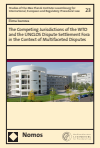The Competing Jurisdictions of the WTO and the UNCLOS Dispute Settlement Fora in the Context of Multifaceted Disputes
Zusammenfassung
Die Arbeit untersucht die Interaktion zwischen den Streitbeilegungsmechanismen, die im Rahmen des SRÜ und des WTO-Abkommens eingerichtet wurden. Sie erforscht zugleich die Herausforderungen, die Streitigkeiten für internationale Gerichte mit begrenzter Zuständigkeit darstellen. Aus Sicht des WTO-Vertrages und des SRÜ gibt die Arbeit konkrete Antworten auf folgende Fragen: Inwieweit können die genannten Entscheidungsgremien angesichts ihrer begrenzten Zuständigkeit auf andere Regeln des Völkerrechts verweisen? Welche Auswirkungen haben die Äußerungen der Gerichte in Bezug auf den WTO-Vertrag und umgekehrt? Wie sollten Gerichte an Streitigkeiten herangehen, die sowohl WTO-Recht als auch Seerecht betreffen? Wie ist ihr Zusammenspiel geregelt?
Die Arbeit bietet Lösungen für vielschichtige Streitigkeiten und trägt damit zur Diskussion über das internationale Verfahrensrecht und das Zusammenspiel von Verträgen und Streitbeilegungsmechanismen bei.
Abstract
The work examines the interaction between the dispute settlement mechanisms established under the UNCLOS and the WTO Agreement, while exploring the challenges that multifaceted disputes straddling different treaty regimes pose to international courts and tribunals of limited jurisdiction such as the WTO DSB and UNCLOS courts and tribunals. It addresses these challenges through the lens of the WTO treaty and the UNCLOS, while providing answers to the following questions: to what extent the mentioned specialized adjudicatory bodies can refer to other rules of international law, especially treaty rules, given their limited jurisdiction; what the implications of the pronouncements of the UNCLOS courts and tribunals are with respect to the WTO DSB and vice versa; how should they approach multifaceted disputes involving both WTO law and law of the sea issues; what rules govern their interaction. The work examines and systematizes the latter rules, while particularly focusing on res judicata. Concerning res judicata, it tackles the questions what the status and meaning of res judicata is and to what types of preclusive pleas it can give rise in international law; whether it can operate as an inter-systemic rule. The work proposes solutions in case a multifaceted dispute allegedly involving different treaties and different branches of international law is submitted for resolution before different dispute settlement fora of limited jurisdiction and in doing so it contributes to the discussion on international procedural law and interaction of treaties and dispute settlement mechanisms.

